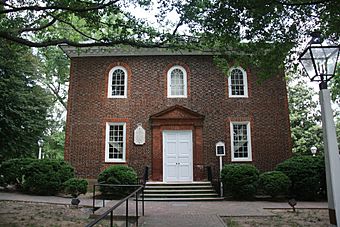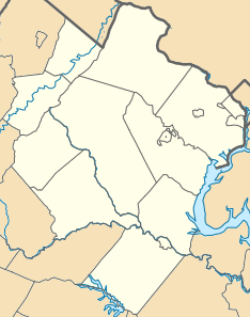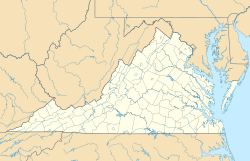The Falls Church facts for kids
|
Falls Church
|
|
 |
|
| Location | 115 E. Fairfax St., Falls Church, Virginia |
|---|---|
| Area | 0 acres (0 ha) |
| Built | 1767 |
| Architect | Col. James Wren |
| NRHP reference No. | 70000870 |
Quick facts for kids Significant dates |
|
| Added to NRHP | February 26, 1970 |
The Falls Church is a very old and important Episcopal church. It is located in Falls Church, Virginia, a city near Washington, D.C.. The city itself is named after this church! The church started in 1732. Its brick building, built in 1769, is still used today.
Contents
History of The Falls Church
Early Days and First Building
The story of The Falls Church began with a landowner named William Gunnell. He moved to the area in 1729. In 1730, he found a minister and started a group of churchgoers. They met in his home until 1733. That year, the first church building was constructed. Before this, the closest church was Pohick Church, quite a distance away.
The first church building was made of wood. It was known as "William Gunnell's Church." Colonel Richard Blackburn designed and built it. The church was about 40 feet long and 22 feet wide. It cost 33,500 pounds of tobacco to build! This new church served an area called Truro Parish. This parish was created in 1732. The church was built on land owned by Michael Reagan. Later, John Trammell bought the land. In 1746, he sold the two-acre lot to the church leaders, called the vestry. By then, it was known as the Upper Church.
The church was first called "Falls Church" in 1757. This was because of its location. It was at the crossing of a road to the Little Falls of the Potomac River. It was also on a main road from Alexandria to Leesburg. This road is now Virginia Route 7.
Important historical figures were involved with the church. George Mason became a vestryman in 1748. George Washington also joined the vestry in 1762.
Building the New Brick Church
By 1762, the wooden church building was getting old and worn out. The church leaders decided to build a new one. It would be made of brick and stand in the same spot. In 1763, George Washington and George William Fairfax took charge. They were responsible for hiring people to build the new church. After 1765, this church became the main church for the new Fairfax Parish.
Colonel James Wren, a member of the vestry, designed the new church. Construction began in 1767. It was finished in late 1769. The Wren building is still standing today. It is located between S. Washington, E. Broad, and E. Fairfax Streets. This 1769 building is the oldest church structure north of Quantico, Virginia. It is also one of the oldest church buildings in the United States.
The Church During the Revolutionary War
During the American Revolutionary War, the Fairfax Militia recruited soldiers from the church. It is said that after the war ended, the Declaration of Independence was read to people from the church steps. In 1784, the Commonwealth of Virginia changed its laws. The Anglican Church was no longer the official state church.
Because of these changes, The Falls Church was left empty for almost 50 years. In 1836, an Episcopal group started using it again. Francis Scott Key, who wrote "The Star-Spangled Banner," was a lay reader here. Henry Fairfax used his own money to help fix up the building in 1838 and 1839.
Civil War and Repairs
During the American Civil War, the church was used by Union soldiers. It served as a hospital and later as a stable for horses. After the war, church services started again. The church has been used continuously for worship since about 1873.
The inside of the church was repaired after the war. The U.S. government paid for the damage caused by Union forces. You can still see some of these repairs today. Look at the brickwork below the windows. Also, check the lower part of the brick doorway at the west end of the church.
The church was updated in 1908. It was also greatly renovated in 1959. Galleries, which were part of the original design but never built, were added. A new chancel, which is the area around the altar, was also built. Other than these repairs and additions, the church still looks much like it did in 1769.
Church Ownership Discussions
Between 2006 and 2014, the church community faced some disagreements. These disagreements were about religious issues. The church buildings and property became part of a long legal discussion.
In 2006, most of the church members voted to separate from the Episcopal Church in the United States of America (ECUSA). They wanted to join a different group called the Convocation of Anglicans in North America (CANA). A smaller group of members stayed with the Episcopal Church. They started holding services at a nearby Presbyterian church.
The larger group, which had separated, renamed itself the Falls Church (Anglican). They continued to worship at the historic Falls Church property. They asked a local court to transfer ownership of the property to CANA. The Episcopal Diocese of Virginia disagreed with this. They fought to keep the property.
After many court decisions and appeals, the Virginia Supreme Court made a final ruling. The church property stayed with The Episcopal Church. The Episcopal parish returned to worship at the historic church. The Anglican parish moved to a different location. In March 2014, the U.S. Supreme Court decided not to hear another appeal. This brought the matter to an end.




